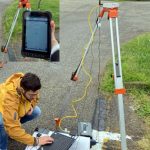To drive the development of optical positioning, navigation and timing (PNT) technology, the European Space Agency (ESA) has signed a contract with a consortium of companies that will conduct a definition study (Phase A/B1) and associated critical technology predevelopment.
This is the first step toward a potential in-orbit demonstrator for optical time synchronisation and ranging (OpSTAR) that will be proposed at the ESA Council at Ministerial Level in November 2025, to validate intersatellite optical links before future use in operational satellite navigation systems.
Optical links, which transmit data using laser beams instead of radio signals, are already well established in the field of satellite communications. To be used in navigation, they still require technological advancements and in-orbit validation of the end-to-end system concept.
ESA aims to develop and test optical technology for time synchronisation and ranging. To that end, the agency has signed a contract with a consortium led by German OHB System as prime industry to conduct a concept definition study (Phase A/B1 study) and technology predevelopments. The European consortium involves 33 companies from across ESA Member states.
After this study, the next step would be to develop and test the technology in-orbit in order to validate novel system concepts and explore new architectures. The results will assess the readiness of optical technology and provide essential inputs for decision-makers with regards to incorporating it into future operational systems.
Javier Benedicto, ESA Director of Navigation: “We are thrilled to kick off this project now, as we gear up to the ESA Council at Ministerial Level in November, a crucial milestone in demonstrating the benefits of new technologies and shaping the future of navigation in Europe.”
José Ángel Ávila Rodríguez, Head of Future Programmes at ESA Navigation: “In addition to laying the foundation for a future in-orbit demonstration, OpSTAR will contribute to define an international interoperability standard for optical timing and ranging in PNT. By involving the main industry players at this early stage, we empower European industry to keep leading global PNT and benefit from potential implementation in future operational systems that use this technology.”
The use of laser beams has the potential to provide additional resilience and robustness at system level, reducing reliance on space atomic clocks and ground segment. Optical links are also immune to jamming and spoofing by nature.
Thanks to the high data transfer rates, intersatellite optical links also have the potential to enable new, more robust architectures, supporting a multi-layer system of systems approach to navigation, in line with the vision of the ESA’s LEO-PNT programme.
In addition, the superior precision offered by optical systems is expected to improve the performance of current navigation systems by an order of magnitude—reaching millimetre-level spatial accuracy and picosecond-level timing, ultimately enabling better services to benefit billions of users around the world.






